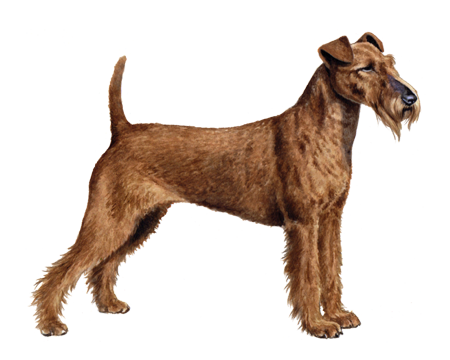
Lakeland Terrier
Lakeland Terriers are intelligent and inquisitive dogs. They love to explore and be with their families—whether on an outdoor adventure or hanging out at home. This kid-friendly breed is gentle, quiet, and finds human companionship irresistible.
Interested in discovering if your dog is a Lakeland Terrier?
Check out Wisdom Panel's DNA tests.

Lakeland Terrier Traits
General Appearance
The Lakeland Terrier has a boxy shape and is well-muscled for a small dog. Contact yet athletic, it's quite representative of the terrier group.
Coat and Colouring
The Lakeland Terrier has a wiry double coat, which may be straight or slightly wavy over the body. This coat comes in various colors, including blue (gray), black, liver, red, and wheaten. Some Lakeland Terriers have a darker saddle pattern that comes in black, blue, liver, or grizzle (i.e., some black hairs).
Distinctive Physical Traits
Small, folded, V-shaped ears flank the Lakeland Terrier's rectangular head. The breed also has long legs (at least compared to most terriers).
Lakeland Terrier Temperament
Self-assured, bold, energetic, and (sometimes) clownish all describe the Lakeland Terrier. Intense, hardworking dogs, Lakeland Terriers aren't afraid of taking on whatever comes their way.
Lakeland Terriers are also alert and will bark to make themselves heard. These qualities make them effective watch dogs. They generally like people and are usually friendly with other dogs. However, they may chase or hunt wildlife due to their natural hunting instincts. In fact, they may take off after anything that's running.
Once Lakelands lock in on an activity—such as barking or digging—they can be difficult to disengage.


Lakeland Terrier History
Lakeland Terriers originated in the early 20th century in the Lake District region of northern England. Once known as the Patterdale, Fell, and Elterwater Terrier, the breed hunted foxes, otters, and badgers to great success. Thanks to their build and agility, they could pursue prey deep into tunnels.
Because of World War I, there was no serious interest in Lakeland Terriers until 1921—at which time they earned their current name. One of the oldest surviving working terrier breeds, the Lakeland Terrier received American Kennel Club recognition in 1934.
Lakeland Terrier Care
Nutrition
The Lakeland Terrier requires a high-quality, age-appropriate dog food. And it's important to monitor the amount of food your Lakeland Terrier eats and reduce the portions if they gain weight. Also, remember that giving too many treats in addition to regular meals can contribute to obesity.
Grooming
Lakelands have a rough double coat that needs a gentle pull (called plucking). You can clip the top layer of dead fur, but this may cause the coat's color to fade. Once clipped, the coat turns out soft, loose curls. Weekly brushing will help prevent loose hairs and mats.
The Lakeland Terrier is considered a non-shedding breed. For this reason, Lakelands may be a good option for those with allergies or anyone who can't bear the thought of dander.
Exercise
Lakeland Terriers are very playful and require ample physical and mental exercise. Though they're not overly energetic, they enjoy long walks, jogs alongside a bicycle, and hardy play in a securely fenced area.
Lakelands also like to participate in many dog sports—such as earthdog trials, retrieving, agility, tracking, and flyball. Hiking and swimming are other fun activities to try.
Training
Training for Lakeland Terriers should be consistent and gentle. They are a smart breed and quick to learn, but they don't like repetition. Though determined, Lakeland Terriers respond well to reward-based training approaches. (For example, you can try exchanging a tasty treat for something they shouldn't have retrieved.)
Early socialization with other pets is necessary to help your Lakeland Terriers develop into well-mannered, well-adjusted adult dogs.

Lakeland Terrier Genetic Health Conditions
-
Primary Lens Luxation
Primary Lens Luxation (PLL) is a condition that can cause the lens of the eye to become loose and eventually displace. The disorder is caused by degeneration of the fibers that hold the lens in place.
Knowing if your Lakeland Terrier is a carrier or at-risk for these conditions can help you and your veterinarian plan for your pup's lifelong care. With Wisdom Panel™ Premium, you can get results for over 200 genetic health tests.
Breed Group
Terrier
The Terrier Group ancestors were bred to hunt and kill vermin. They are often characterized as feisty and energetic dogs whose sizes range from fairly small to much larger.
Resources
https://animals.net/lakeland-terrier/
https://www.akc.org/dog-breeds/lakeland-terrier/
Reviewed 26 July 2020 by Cindy Elston, DVM, MPH































































